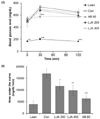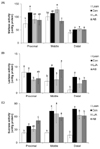1. Chen L, Magliano DJ, Zimmet PZ. The worldwide epidemiology of type 2 diabetes mellitus--present and future perspectives. Nat Rev Endocrinol. 2011; 8:228–236.

2. Fuller JH, Shipley MJ, Rose G, Jarrett RJ, Keen H. Coronary-heart-disease risk and impaired glucose tolerance. The Whitehall study. Lancet. 1980; 1:1373–1376.

3. American Diabetes Association. Diagnosis and classification of diabetes mellitus. Diabetes Care. 2010; 33:Suppl 1. S62–S69.
4. Krasikov VV, Karelov DV, Firsov LM. α-Glucosidases. Biochemistry (Mosc). 2001; 66:267–281.
5. Scheen AJ. Is there a role for α-glucosidase inhibitors in the prevention of type 2 diabetes mellitus? Drugs. 2003; 63:933–951.

6. Holman RR, Turner RC. Oral agents and insulin in the treatment of NIDDM. In : Pickup JC, Williams G, editors. Textbook of Diabetes. Oxford: Blackwell;1991. p. 467–469.
7. Kim SH, Hyun SH, Choung SY. Anti-diabetic effect of cinnamon extract on blood glucose in db/db mice. J Ethnopharmacol. 2006; 104:119–123.

8. Rojo LE, Ribnicky D, Logendra S, Poulev A, Rojas-Silva P, Kuhn P, Dorn R, Grace MH, Lila MA, Raskin I. In vitro and in vivo anti-diabetic effects of anthocyanins from Maqui Berry (Aristotelia chilensis). Food Chem. 2012; 131:387–396.

9. Chernenko TV, Glushenkova AI, Rakhimov DA. Lipids of Helianthus tuberosus tubers. Chem Nat Compd. 2008; 44:1–2.

10. Kim HS, Han GD. Hypoglycemic and hepatoprotective effects of Jerusalem artichoke extracts on streptozotocin-induced diabetic rats. Food Sci Biotechnol. 2013; 22:1121–1124.

11. Rumessen JJ, Bodé S, Hamberg O, Gudmand-Høyer E. Fructans of Jerusalem artichokes: intestinal transport, absorption, fermentation, and influence on blood glucose, insulin, and C-peptide responses in healthy subjects. Am J Clin Nutr. 1990; 52:675–681.

12. Park BS. Effect of oral administration of Jerusalem artichoke inulin on reducing blood lipid and glucose in STZ-induced diabetic rats. J Anim Vet Adv. 2011; 10:2501–2507.

13. Kaur N, Gupta AK. Applications of inulin and oligofructose in health and nutrition. J Biosci. 2002; 27:703–714.

14. Mohamed Sham Shihabudeen H, Hansi Priscilla D, Thirumurugan K. Cinnamon extract inhibits α-glucosidase activity and dampens postprandial glucose excursion in diabetic rats. Nutr Metab (Lond). 2011; 8:46.

15. Barham D, Trinder P. An improved colour reagent for the determination of blood glucose by the oxidase system. Analyst. 1972; 97:142–145.

16. Lowry OH, Rosebrough NJ, Farr AL, Randall RJ. Protein measurement with the Folin phenol reagent. J Biol Chem. 1951; 193:265–275.

17. Jung HW, Jung JK, Ramalingam M, Yoon CH, Bae HS, Park YK. Anti-diabetic effect of Wen-pi-tang-Hab-Wu-ling-san extract in streptozotocin-induced diabetic rats. Indian J Pharmacol. 2012; 44:97–102.

18. Baldini M, Danuso F, Turi M, Vannozzi GP. Evaluation of new clones of Jerusalem artichoke (Helianthus tuberosus L.) for inulin and sugar yield from stalks and tubers. Ind Crops Prod. 2004; 19:25–40.

19. Rakhimov DA, Arifkhodzhaev AO, Mezhlumyan LG, Yuldashev OM, Rozikova UA, Aikhodzhaeva N, Vakil MM. Carbohydrates and proteins from Helianthus tuberosus. Chem Nat Compd. 2003; 39:312–313.

20. Suseelan KN, Mitra R, Pandey R, Sainis KB, Krishna TG. Purification and characterization of a lectin from wild sunflower (Helianthus tuberosus L.) tubers. Arch Biochem Biophys. 2002; 407:241–247.

21. Boillot J, Alamowitch C, Berger AM, Luo J, Bruzzo F, Bornet FR, Slama G. Effects of dietary propionate on hepatic glucose production, whole-body glucose utilization, carbohydrate and lipid metabolism in normal rats. Br J Nutr. 1995; 73:241–251.

22. Luo J, Rizkalla SW, Alamowitch C, Boussairi A, Blayo A, Barry JL, Laffitte A, Guyon F, Bornet FR, Slama G. Chronic consumption of short-chain fructooligosaccharides by healthy subjects decreased basal hepatic glucose production but had no effect on insulinstimulated glucose metabolism. Am J Clin Nutr. 1996; 63:939–945.

23. Yang HJ, Kwon DY, Kim MJ, Kang S, Kim DS, Park S. Jerusalem artichoke and chungkookjang additively improve insulin secretion and sensitivity in diabetic rats. Nutr Metab (Lond). 2012; 9:112.

24. Delzenne NM, Kok N. Effect of non-digestible fermentable carbohydrates on hepatic fatty acid metabolism. Biochem Soc Trans. 1998; 26:228–230.











 PDF
PDF ePub
ePub Citation
Citation Print
Print


 XML Download
XML Download